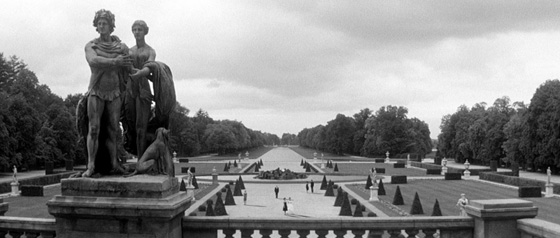 “This piece of music which has gone on for some time, perhaps even since the beginning of the evening, is a kind of cyclically repeated refrain in which the same passages can always be recognized at regular intervals…” – Alain Robbe-Grillet, La Maison de Rendez-vous (1965)
“This piece of music which has gone on for some time, perhaps even since the beginning of the evening, is a kind of cyclically repeated refrain in which the same passages can always be recognized at regular intervals…” – Alain Robbe-Grillet, La Maison de Rendez-vous (1965)
“And once again I walk down those same corridors, walking for days, for months, for years, in search of you.” – X., Last Year at Marienbad
Last Year at Marienbad (1961) is one of those monolithic films, notoriously “difficult,” the prototypical Art House Film. But no film is truly “difficult” unless you are not paying attention, or the director is not doing his job as a storyteller. A “difficult” film might be confusing because it’s unfocused, sloppy. Last Year at Marienbad is none of these things. I’d argue that it isn’t difficult, because there is not a definite solution to be riddled out of it. Frame for frame, it is exactly what it is supposed to be, and – again, if you watch it without distraction, and bring your best efforts – you will be left in the same state of mind as the protagonist, uncertain, soaked in passions, wandering in the darkness. That’s what the film is about.
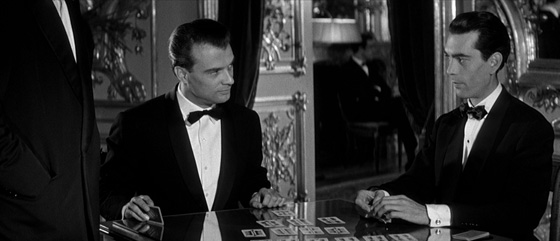 But to say that the film has no conventional narrative is an understatement. The film was a grand experiment. Alain Resnais had previously directed Hiroshima Mon Amour (1959), which was written by an acclaimed experimental novelist, Marguerite Duras. For his follow-up, he again requested a screenplay from a pioneer of the nouveau roman: Alain Robbe-Grillet, whose novels took place in the past, present, and future simultaneously, and routinely switched tenses and from third- to first-person and back again, too fickle to settle on any single costume for the party. The two Alains presented a formidable artistic force. Robbe-Grillet had submitted a script as though it were simply another of his mind-bending psychological novels, with little concession toward traditional cinematic qualities. Resnais filmed it exactly as it was, posing his characters to his screenplay’s exact specifications, switching scenes and moods with every edit, and refusing to trim Robbe-Grillet’s trademark circular narration, which circles and circles the same phrases and imagery: “…Silent rooms, where one’s footsteps are absorbed by carpets so thick, so heavy, that no sound reaches one’s ear, as if the very ear of he who walks on once again along these corridors, through these salons and galleries in this edifice of a bygone era, this sprawling, sumptuous, baroque, gloomy hotel, where one endless corridor follows another; silent, empty corridors, heavy with cold, dark woodwork, stucco, molded paneling, marble, black mirrors, dark-toned portraits, columns, sculpted doorframes, rows of doorways, galleries, side corridors, that in turn lead to empty salons, salons heavy with ornamentation of a bygone era…”
But to say that the film has no conventional narrative is an understatement. The film was a grand experiment. Alain Resnais had previously directed Hiroshima Mon Amour (1959), which was written by an acclaimed experimental novelist, Marguerite Duras. For his follow-up, he again requested a screenplay from a pioneer of the nouveau roman: Alain Robbe-Grillet, whose novels took place in the past, present, and future simultaneously, and routinely switched tenses and from third- to first-person and back again, too fickle to settle on any single costume for the party. The two Alains presented a formidable artistic force. Robbe-Grillet had submitted a script as though it were simply another of his mind-bending psychological novels, with little concession toward traditional cinematic qualities. Resnais filmed it exactly as it was, posing his characters to his screenplay’s exact specifications, switching scenes and moods with every edit, and refusing to trim Robbe-Grillet’s trademark circular narration, which circles and circles the same phrases and imagery: “…Silent rooms, where one’s footsteps are absorbed by carpets so thick, so heavy, that no sound reaches one’s ear, as if the very ear of he who walks on once again along these corridors, through these salons and galleries in this edifice of a bygone era, this sprawling, sumptuous, baroque, gloomy hotel, where one endless corridor follows another; silent, empty corridors, heavy with cold, dark woodwork, stucco, molded paneling, marble, black mirrors, dark-toned portraits, columns, sculpted doorframes, rows of doorways, galleries, side corridors, that in turn lead to empty salons, salons heavy with ornamentation of a bygone era…”
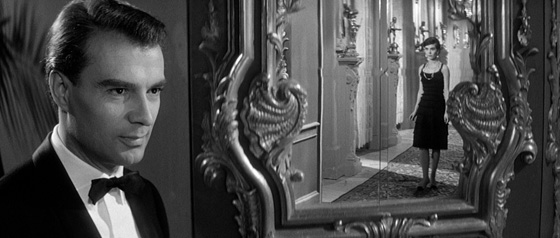 If the dictum of cinema is to show-not-tell, Resnais stubbornly does both, reading off Robbe-Grillet’s cyclical prose as he depicts the winding, ever-changing hallways of the hotel, as vast and eerie as Bergman’s in The Silence (1963) or Kubrick’s in The Shining (1980). Our narrator is only called “X.” in the screenplay, and he’s played by Giorgio Albertazzi, an Italian actor in the suave, seductive mode of Marcello Mastroianni. Within the confines of an elegant and sprawling hotel, he meets a woman, “A.” (Delphine Seyrig), who is married to a tall, gaunt figure, “M.” (Sacha Pitoëff). X.’s narration is actually a monologue delivered to A., trying to convince her that they met one year ago, possibly in Frederiksbad, possibly in Marienbad, possibly somewhere else. She denies ever knowing him. He describes how he first saw her; how they discussed the statue upon the terrace and what it might be; how he took a photograph of her sitting upon a white bench; how she broke the heel of her shoe; how her husband suspected them. And she denies all of it.
If the dictum of cinema is to show-not-tell, Resnais stubbornly does both, reading off Robbe-Grillet’s cyclical prose as he depicts the winding, ever-changing hallways of the hotel, as vast and eerie as Bergman’s in The Silence (1963) or Kubrick’s in The Shining (1980). Our narrator is only called “X.” in the screenplay, and he’s played by Giorgio Albertazzi, an Italian actor in the suave, seductive mode of Marcello Mastroianni. Within the confines of an elegant and sprawling hotel, he meets a woman, “A.” (Delphine Seyrig), who is married to a tall, gaunt figure, “M.” (Sacha Pitoëff). X.’s narration is actually a monologue delivered to A., trying to convince her that they met one year ago, possibly in Frederiksbad, possibly in Marienbad, possibly somewhere else. She denies ever knowing him. He describes how he first saw her; how they discussed the statue upon the terrace and what it might be; how he took a photograph of her sitting upon a white bench; how she broke the heel of her shoe; how her husband suspected them. And she denies all of it.
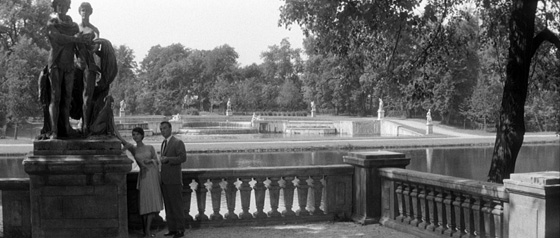 Resnais conveys great dislocation by playfully alternating the environment from shot to shot. There is no continuity, by design. Seyrig’s dress shifts from white to black, as do the hallways; even the painting of the hotel garden is swapped with one in negative, the whites becoming blacks and vice versa. Three different palaces were used to stand in for a single hotel; a character will stand in one corridor, turn around, and face a corridor in a completely different building. The statue itself moves around just as much as X. and A. do, at one point overlooking the gardens (facing in either direction), at another point overlooking a river or lake. Resnais staged one unnerving shot not unlike a Magritte painting, with the perfectly-still guests in the gardens casting long, slanting shadows, but the conical shrubbery around them casting none. This was achieved by painting false shadows beside the extras. For all that effort, on a first viewing you might not even notice; but it feels wrong; it feels alarming.
Resnais conveys great dislocation by playfully alternating the environment from shot to shot. There is no continuity, by design. Seyrig’s dress shifts from white to black, as do the hallways; even the painting of the hotel garden is swapped with one in negative, the whites becoming blacks and vice versa. Three different palaces were used to stand in for a single hotel; a character will stand in one corridor, turn around, and face a corridor in a completely different building. The statue itself moves around just as much as X. and A. do, at one point overlooking the gardens (facing in either direction), at another point overlooking a river or lake. Resnais staged one unnerving shot not unlike a Magritte painting, with the perfectly-still guests in the gardens casting long, slanting shadows, but the conical shrubbery around them casting none. This was achieved by painting false shadows beside the extras. For all that effort, on a first viewing you might not even notice; but it feels wrong; it feels alarming.
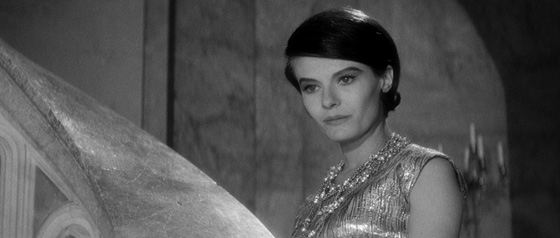 The constant dislocation is essential to the story, because we are not in any one place – we are not in “reality” – but in the thoughts and feelings of X. and (possibly, alternately) A. He is telling her that it happened like this, or possibly like that, and she resists, imagines, denies, counter-offers, fantasizes, dreads. It’s a struggle of wills, in which his version of events battles with hers. As was psychologically in fashion, there is no “objective” truth, but only subjectivity. So this is a tale set only in competing subjective realities (I’m reminded of the science fiction novels of Philip K. Dick, in particular 1957’s Eye in the Sky).
The constant dislocation is essential to the story, because we are not in any one place – we are not in “reality” – but in the thoughts and feelings of X. and (possibly, alternately) A. He is telling her that it happened like this, or possibly like that, and she resists, imagines, denies, counter-offers, fantasizes, dreads. It’s a struggle of wills, in which his version of events battles with hers. As was psychologically in fashion, there is no “objective” truth, but only subjectivity. So this is a tale set only in competing subjective realities (I’m reminded of the science fiction novels of Philip K. Dick, in particular 1957’s Eye in the Sky).
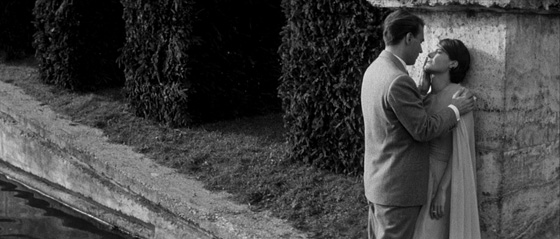
Or maybe not. There is a powerful scene where A. discovers, in a drawer, a pile of copies of the same photograph, the one X. insisted he took of her. She spreads them in rows upon her bed, in the same manner as the game which her husband, M., loves to play, and always wins. When someone faces that game, they lose: and she stares at the photos, just as defeated, because here is Evidence. Something happened. Something is real. In that photo, she is sitting upon a bench, smiling happily at the cameraman. Can she still deny the affair? But who really took that picture?
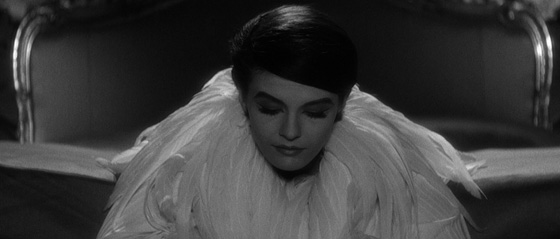 Another possibility is that this is a haunted house tale, but told from the point of view of ghosts (one, or all of them). We even witness a potential, tragic end, when M. bursts into the bedroom occupied by A., and shoots her with a pistol. This may not have happened. It’s offered up, but the story continues, and X. talks on. Something dreadful occurred, however. That dreadful thing might simply be that she acquiesced to the seduction, and cheated on her husband. But many viewers (including my wife) see this as a story about rape. In a metaphorical sense, this must be true, since X. moves from seduction to more emphatically pressing his version of events upon the unwilling A. But there is also a moment – which happened, one year ago in one way or another – in which X. storms violently into A.’s hotel room and…what? The film does not say. Very suspiciously, X. drops a line that he did not “force” her, delivered in such a way that it reeks of guilt. Resnais films the confrontation as a fantasy sequence from X.’s P.O.V., with A.’s arms outstretched and an ecstatic smile for her lover, but the camera plunges toward her in a sudden spasm, the score shrieks loudly, the film is overexposed, bleaching white: cinematically, it is rape, and X.’s denials of force merely point the finger more emphatically toward this interpretation. Is this entire, ninety-minute monologue just X. breaking through A.’s repressed memories of a casual flirtation that led to sexual assault?
Another possibility is that this is a haunted house tale, but told from the point of view of ghosts (one, or all of them). We even witness a potential, tragic end, when M. bursts into the bedroom occupied by A., and shoots her with a pistol. This may not have happened. It’s offered up, but the story continues, and X. talks on. Something dreadful occurred, however. That dreadful thing might simply be that she acquiesced to the seduction, and cheated on her husband. But many viewers (including my wife) see this as a story about rape. In a metaphorical sense, this must be true, since X. moves from seduction to more emphatically pressing his version of events upon the unwilling A. But there is also a moment – which happened, one year ago in one way or another – in which X. storms violently into A.’s hotel room and…what? The film does not say. Very suspiciously, X. drops a line that he did not “force” her, delivered in such a way that it reeks of guilt. Resnais films the confrontation as a fantasy sequence from X.’s P.O.V., with A.’s arms outstretched and an ecstatic smile for her lover, but the camera plunges toward her in a sudden spasm, the score shrieks loudly, the film is overexposed, bleaching white: cinematically, it is rape, and X.’s denials of force merely point the finger more emphatically toward this interpretation. Is this entire, ninety-minute monologue just X. breaking through A.’s repressed memories of a casual flirtation that led to sexual assault?
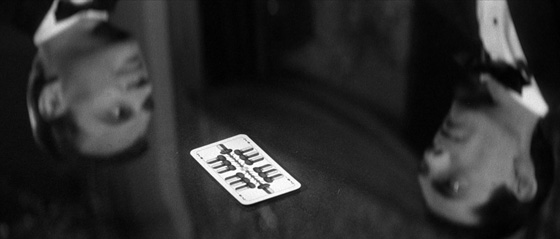 Yet what then does one make of the scenes which follow? A. agrees to wait for X. (this is still delivered in the past tense) and they will run off together – which happens, as she abandons her husband and steps off into the pitch-dark night. When did this happen – one year ago, or in the present? It can’t be a year ago, because we know that they parted ways (in Frederiksbad, or Marienbad): “And you asked me to give you a year, thinking perhaps to test me, or wear me down, or just forget all about me. But time doesn’t count.” So, one assumes, we are in the present, and he has at last won his argument, and persuaded A. of his reality, whether or not they really have met before (because maybe they haven’t, and this is all a con of seduction). But time doesn’t count in the fictions of Robbe-Grillet, nor in the world of Last Year at Marienbad. Neither is there any line between memory and fantasy. It’s possible for a dozen people to go see Marienbad together and walk out with a dozen different interpretations, all of them equally valid. It is not a “difficult” film, because that was supposed to happen.
Yet what then does one make of the scenes which follow? A. agrees to wait for X. (this is still delivered in the past tense) and they will run off together – which happens, as she abandons her husband and steps off into the pitch-dark night. When did this happen – one year ago, or in the present? It can’t be a year ago, because we know that they parted ways (in Frederiksbad, or Marienbad): “And you asked me to give you a year, thinking perhaps to test me, or wear me down, or just forget all about me. But time doesn’t count.” So, one assumes, we are in the present, and he has at last won his argument, and persuaded A. of his reality, whether or not they really have met before (because maybe they haven’t, and this is all a con of seduction). But time doesn’t count in the fictions of Robbe-Grillet, nor in the world of Last Year at Marienbad. Neither is there any line between memory and fantasy. It’s possible for a dozen people to go see Marienbad together and walk out with a dozen different interpretations, all of them equally valid. It is not a “difficult” film, because that was supposed to happen.
And somewhere, I am sure, X. and A. are still wandering the hotel together, seducing and resisting, last year and this one, and the next one…
Screen caps via DVDBeaver.









